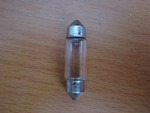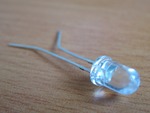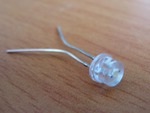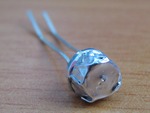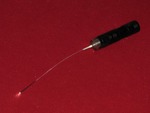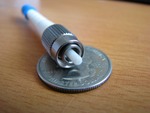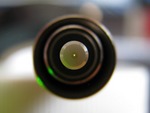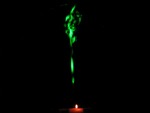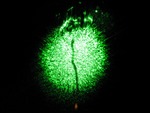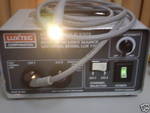Point Light Source Examples
Here I describe several ways of making a bright pinhole light source. Not all of these are actual pinholes, the first in fact is a long line. But as long as the light source is shaped like the obstruction it will work. Using a auto taillight and a razor blade works because you can align both with care. If making a pinhole you want something around 400 microns which comes out to 0.4mm wide. Click on an image below for a larger view.So first is the easiest to get, a few dollars for an automotive taillight bulb. The reason this is used is that the filament is very straight and thin. A curved, looped or multiple filament bulb will not work for this.
Care must be taken to make the filament align up with the razors edge. You can turn the bulb around until you find the flattest edge, then mount it upright. It takes a 12v power supply.
This takes more work but produces a much better image. Using sandpaper sand away the dome of a bright white LED until you have ALMOST reached the die. Sometimes there is a hair thin wire that sticks up a bit so you might have to stop a bit early. You can find 50,000 mcd LEDs in packs of 30 for about $10 on eBay, so buy a bunch so you can break a few without worry.
I then used some silver tape with a pinhole (made by a pin of course) which I stuck to the front. Do it while the LED is on so you can position it to give the brightest light. Folding it down over the rest of the LED cuts back on the light as well as securing it better. Careful not to tape the foil to the leads!
You then need a power supply. Depending on the LED you use it will have a requirement such as 3.4v @ 40mA. The 40mA bit is what gets most people. Unlike a light bulb, an LED has zero resistance, so it acts like a dead short. Easy to burn it up by hooking it direct to 3.4v. You need a higher voltage and a resistor to match, or better, a current limited power supply made for LEDs. There are tons of web sites on how to wire LEDs so I'll not go into it any deeper here.
The best method I have found is to use a fiber optic cable with a very bright light source fed into it with a condensing lens. Shown here is a 3 watt LED flashlight taped to a condensing lens and hooked to some thick gauge fiber optic cable. The end is dipped in black Plasti-Dip since this particular fiber is damaged and light leaks out all over. It gives a seriously bright light, but is large compared to most fiber. This is what I am using now.
The second two images are of an FC connector which can screw into the lens I have on the flashlight. The fiber in it is VERY small. In fact you can only see it in the second closeup because I am shining a green laser into the other end.
The light is a pinpoint no matter how close you look at it, and would be perfect except it is SO tiny it is very dim. I can still use it, but only with very slow shutter speeds that blur most things. I am working on putting together a much brighter light source to try and feed the fiber with. It should give much sharper images.
This was an experiment with a very bright laser. It didn't work very well at all, as the two images to the left show. These were the best of the bunch. I tried both the bare laser as well as making a pinhole foil cover for it, but that was even worse.
I know a laser can be made to work, I read about using a pulse IR laser for high speed Schlieren images, but I guess more lenses and things are needed to get it to work right. The light is so concentrated I can see why it fails, and I don't have the right lens on hand. I'll try some more experiments later.
Finally, you can go and buy some sort of laboratory light source if you find something really cheap or just like spending money. Just the bulbs on these things go for hundreds of dollars, and they burn out fast too.
Why won't a flashlight or a 200W halogen bulb with a pinhole over it work? The problem with pinhole light sources is you need the light source as close to the pinhole as possible. As soon as there is any distance involved the light starts to scatter and form shapes and interference patterns. Plus, a halogen while bright would melt the aluminum tape right off of it.
If you have a better solution for a super bright, tiny light source be sure to let me know and I'll add it.
Back to my Schlieren Photography Page.
